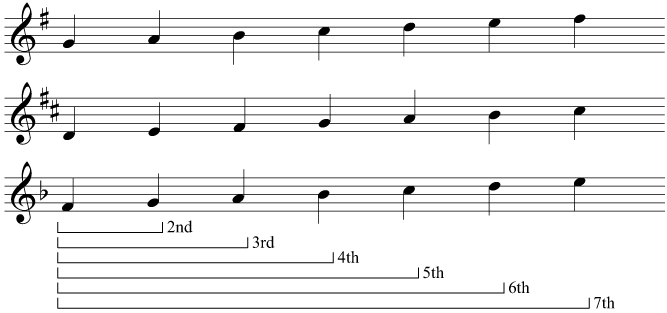Intervals level 1
In this guide...
Key terms:
Subscription required!
To view the complete study guide, you will need a valid subscription. Why not subscribe now?
Already have a subscription? Make sure you login first!
Introduction
We've already discovered semitones and tones between adjacent notes, so we'll start with a quick recap on those. Next we'll take a look at the intervals between notes that are not adjacent.
A quick recap
Let's begin with a quick reminder of some things we've learned in the previous study guide, and start with a list of the natural notes:
C, D, E, F, G, A, B, C
Remember that there are gaps "between" some of these notes, which allow us to have sharp and flat versions of the natural notes.
Tones and semitones
The gap between a natural note and its sharpened or flattened version is an interval called a semitone, and the reason that there is no sharp (or flat) note between B and C or between E and F is because these natural notes are already a semitone apart, and so there is no "room" for a sharp or flat between them.
The interval between two natural notes which is large enough to contain a flat or sharp is called a tone. Therefore, there are tones between these pairs of natural notes:
- C and D
- D and E
- F and G
- G and A
- A and B
Wider intervals
An interval doesn't just have to be a semitone or a tone. In fact, we can describe the gap between any two notes with a system of describing intervals that is very important to the study of music theory.
Let's consider the list of natural notes again, and this time let's number them:
- C
- D
- E
- F
- G
- A
- B
If C (number 1) is the first note, we can see that D is the 2nd note that we come to, and that E is the 3rd. We can therefore say that D is an interval of a 2nd above C, and that E is an interval of a 3rd above C. Similarly, we can construct the intervals of a 4th, 5th, 6th and 7th.
Carrying on with this, we can describe any interval between C and a note above in the same way, as shown in this example:
 The intervals between C and the natural notes above
The intervals between C and the natural notes aboveThe octave
If the interval between C and B is a 7th, what about the interval between C and the C above? Is that an "8th"?
The interval between two notes an "8th" apart is given a special name: an octave. It is not correct to use the term "an 8th", so you'll need to remember the word "octave" - fortunately, you'll come across it a lot, so it's an easy one to remember!
Here are some examples of octaves:
 Some octave intervals
Some octave intervalsThe unison
Similarly, if the interval between C and D is a 2nd, what about the "interval" between C and itself? Is that a "1st"?
This is another special case. The interval between any two notes that are the same is called a unison. Just as with the octave and "8th", it is not correct to call this interval a "1st", so you'll also need to remember to say "unison" instead.
You'll also come across the word "unison" frequently - for example, we might say that two people are "singing in unison", when we mean that they are singing the same notes at the same time - in other words, the interval between them is always a unison!
Trap: Equivalents
Do you remember the word "equivalents" from the flats and sharps study guide - describing, for example, how C sharp is equivalent to D flat?
This can lead to an important trap! C sharp is not the same note as D flat, it is simply equivalent. Therefore the interval between these two notes - even though they sound the same - is not a unison.
Remember that equivalent notes are written differently even though they sound the same.
C sharp is a "type of" C, and D flat is a "type of" D, and we know that the interval between C and D is a 2nd. Therefore, the interval between C sharp and D flat is also a "type of" 2nd. We'll discover exactly what kind of 2nd in a later study guide, but for now, watch out for this trap!
Starting elsewhere
So far we have just looked at intervals starting on C, in the C major scale. We can use this system for any scale. Here are the intervals in the scales of G major, D major, and F major.
 Intervals in the G, D, and F major scales
Intervals in the G, D, and F major scalesCounting up
Always remember to count up from the lower note when describing an interval, even if the first note in the pair is higher. Both of the following intervals are a 3rd:
 Both of these intervals are 3rds
Both of these intervals are 3rdsIf you don't count up from the lower note, in the example above you might wrongly conclude that the second interval (B to G) is a 6th!
Read more...
With a subscription to Clements Theory you'll be able to read this and dozens of other study guides, along with thousands of practice questions and more! Why not subscribe now?
Revision
Are you sure you've understood everything in this study guide? Why not try the following practice questions, just to be sure!